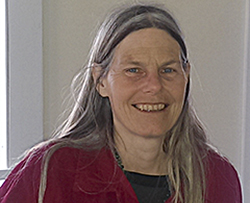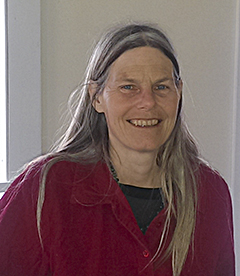

copyright the Chronicle April 22, 2015
by Elizabeth Trail
GREENSBORO — Most of the five women who came to the Greensboro library on Thursday evening knew one another well, giving the gathering an intimate feeling. The occasion was a talk by Judy Jarvis, a homeopathic practitioner, about using homeopathic remedies and essential oils on children. Each of the mothers arrived with questions, mostly about specific issues they were experiencing in their families — a baby with a cold, a growing child with leg cramps, a preteen having trouble falling asleep, a teenager under stress.
However, the first question, asked by Virginia LaPierre, a mother of five children ranging in age from four to 13, was more basic.
“How do I make homeopathy automatic?” she asked. “For example, when one of my children gets a cut or scrape, I reach for the Neosporin. How do I get to the point where I just know which homeopathic treatment to reach for instead?”
“You need to keep good notes,” replied Ms. Jarvis. “Make a chart with each child’s name, and write down what you tried and how it worked. You’ll find that something that works on one child may not work for another, or that something that worked on one child in one situation doesn’t work on the same child when the circumstances are different. Over time, you’ll learn what to reach for.”
Ms. LaPierre looked slightly crestfallen. There are few equivalents in homeopathy to Dr. Benjamin Spock’s Baby and Child Care, that staple of an earlier generation of mothers, which offered one-size-fits-all solutions to the crises of parenting.
Ms. Jarvis, the mother of two now grown children, is also owner of Riverside Farm, a 20-acre organic vegetable farm and CSA outside of Hardwick. She began to use homeopathic remedies when her children were small. Over time, her fascination grew, and in 2004 she went to Canada for a three-year certification course at the Hahnemann College of Heilkunst in Ottawa. She is now in the middle of a two-year program on using essential oils, another alternative therapy which complements her work in homeopathy. As she answered questions about remedies for specific complaints, her recommendations were drawn from both schools of treatment.
“Homeopathy is very specific to circumstances,” she explained. “You have to be able to ask a lot of questions. When you don’t know the answers, or your child doesn’t want to answer, sometimes oils are a better option.”
Essential oils are rubbed onto the skin, placed by the drop on energy points, or diffused into the air. Homeopathic remedies are highly diluted substances, typically sold as tiny sugar pills in glass vials, although there are also homeopathic powders, ointments, and topical preparations.
Ms. Jarvis passed around bottles of essential oils to smell. A delicate patchouli brought smiles, while a bottle of chamomile oil wrinkled some noses. She helped the women find the sensitive pressure points along the body’s energy meridians where the oils should be applied.
Pressure points often feel startlingly different from surrounding tissue when pressed. According to Chinese traditional medicine, each point corresponds to one of the internal organs or glands. Rubbing or pressing the points — the same points used in acupuncture — can free blocked energy and restore balance in the body.
Ms. Jarvis demonstrated a gentle figure eight massage, stroking down the spine and around the shoulder blades. It’s used for helping a child to relax at bedtime.
“I need someone to do that for me!” exclaimed one mother. Heads nodded. In fact, Ms. Jarvis frequently reminded the women that caring for themselves was an essential part of caring for their families.
Homeopathy, an alternative mode of treatment founded in the late 1700s by a German physician named Samuel Hahnemann, is based on the “law of similars,” sometimes phrased as “like cures like.” If a substance causes a given set of symptoms or reactions, homeopathy says that the same substance, in highly diluted form, can be used to treat problems that display those symptoms. In part, because Dr. Hahnemann rejected bloodletting and some of the other harmful practices of the day, patients often did better than they would have with conventional treatment, and homeopathy quickly developed a following.
The vocabulary of homeopathy is strange to modern ears. Many of the substances, such as lead, or arsenic, or belladonna, are toxic at full strength.
In addition to plant extracts, venoms, minerals, and elements, the homeopathic medicine chest includes “nosodes,” which are made from diseased tissue such as tumors, mastitis tissue, pus, or the phlegm from tuberculosis or whooping cough patients. These substances are sterilized, dried, made into a tincture, and then “potentized,” according to homeopathic principles, Ms. Jarvis explained.
Another group of homeopathic remedies are “cell salts,” 12 minerals which were originally identified as essential components of the human body by measuring the quantities of those minerals left behind in the ash residue of cremated bodies.
Cell salts include three types of calcium, three types of phosphorus, and three types of sodium, plus iron, magnesium, and silica. Highly diluted and mixed with lactose, cell salts dissolve quickly in the mouth and are believed to replenish nutrients directly through the mucous membranes.
“Cell salts are more nutritional,” said Ms. Jarvis. “They are a good place to start if you are just learning about homeopathy.”
Successful use of homeopathy requires keen observation, not only of physical symptoms, but also of the patient’s emotional state, circumstances, and even the weather.
“For any set of symptoms, there are many substances which might be appropriate,” said Ms. Jarvis. “You have to keep reading, and look for matches to more specific parts of your situation.”
For example, aconite is appropriate for fevers that come on quickly, especially when the weather is brisk and windy. When the fever is accompanied by damp skin, red cheeks and a throbbing headache, belladonna is the better choice, she told the group.
While some remedies are almost universal, others are gender or age specific. In fact, Ms. Jarvis cautioned several times that certain substances being discussed were fine for adults but were too strong or otherwise not appropriate for children.
Dogs, cats, other pets, and livestock can also be treated homeopathically, but again, the treatments are often species, gender, and circumstance specific, Ms. Jarvis said.
For quick reference, she recommends a book called Everybody’s Guide to Homeopathic Medicine, by Stephen Cummings, MD, and Dana Ullman, MPH. For more in-depth research, she relies on Materia Medica, the central textbook of homeopathy.
Homeopathic preparations are made through a process of repeated dilution and shaking called “potentization.” In standard medical practice, the more concentrated a drug is, the stronger it becomes, but in homeopathy the more diluted a substance is, the more potent it is considered to be.
Preparation of a homeopathic remedy begins by putting one drop of a mother tincture in nine drops of water. One drop of that solution is taken out and diluted with another nine drops of water, and one drop of that solution is taken out and diluted with another nine drops of water. The number on the label tells how many times the process has been repeated.
Critics charge that the resulting solution is so diluted that it contains little, if any, of the labeled ingredient. A 12X solution, for example, contains only one molecule per trillion of the original tincture.
Supporters of homeopathy say that the combination of dilution and shaking leaves a memory of the active substance in the water. There are many stories about remarkable successes with homeopathic treatments.
“Each dilution leaves more energy in the bottle,” explained Ms. Jarvis. “By the time you get to higher levels of potentization, it is working more on a spiritual level than on a physical one, and that is very powerful.”
“Homeopathy’s effectiveness has not been verified by large randomized controlled trials, which is to say we don’t know that it works,” said Mali Royer Zuses, a resident in family medicine at the University of Maryland Medical Center and herself the mother of a young child, in an online interview.
During her medical training, Dr. Zuses worked with a doctor of osteopathy who used homeopathic remedies in his practice.
“His intake appointment for homeopathy was more than an hour long — I think it was the interview that actually helped those patients. Having a compassionate listener focus their attention on you for that long — it was very similar to a therapy session.”
Her own experience with homeopathy was not successful. When her son was born, Dr. Zuses had a post-partum hemorrhage. The midwife treated her first with a homeopathic remedy.
“I remember thinking I hope this isn’t the best she has. Luckily it was not,” Dr. Zuses said. She stopped bleeding after receiving conventional medical treatment.
Ms. Jarvis deflects the question of whether homeopathy can be scientifically proven to be effective.
“People need tools,” she says. “When your child is hurting, you may know that this is a childhood illness and that they will be better in a couple of days, but you want to do something. So you experiment until you find something that helps.”
Dr. Zuses agrees with that perspective. “Sometimes as a parent it helps just to feel like you’re doing something. Plus placebo is a pretty good medicine,” she said.
Homeopathy is generally very safe, Ms. Jarvis said.
“I have tried taking remedies that are supposed to be inimical to each other — that should not be taken together — and I’ve never had a reaction.”
However, she cautioned that children with severe allergies to substances such as bee venom or poison ivy should not be treated with homeopathic remedies that contain that ingredient.
“Homeopathy is not likely to be harmful in and of itself,” says Dr. Zuses. “What concerns me is people using homeopathic remedies instead of evidence-based treatment.”
Ms. Jarvis’s therapeutic approach encourages mothers to be aware — both for themselves and for their children — of eating well, drinking enough water, and getting plenty of rest and exercise. To relieve stress, she advocated talking problems out with a friend or family member, walking outdoors, writing in a journal, or getting a massage.
Essential oils can be mixed with Epsom salts and added to a hot bath for relaxation, she said.
However, homeopathy is not a cure for every ill, Ms. Jarvis warned.
“Be aware of jurisdiction,” she reminded her audience. “Homeopathy won’t correct failure of lifestyle. If your headache is caused by not getting enough sleep or exercise, or smoking, or not drinking enough water, it’s not homeopathy’s job to fix it. You need to get that sleep or exercise, drink enough water, or stop smoking.”
Throughout the session, Ms. Jarvis continued to emphasize that it’s important to listen to children, talk to them, and be sure that all of their physical and emotional needs were being met in addition to specific treatments.
“Help your children honor their bodies and figure out where they hold their emotions,” she advised.
The stories the mothers told, and the questions they asked, reflected their deep involvement with their childrens’ well being. One young mother described rubbing her toddler daughter’s feet with oils when she was fretful at night with a cold. Another helps her children relax for sleep by diffusing lavender oils into the air in their bedrooms.
The final takeaway from the evening was a gentle and positive model of parenting — and a reminder to mothers not to neglect themselves in the process.
For more free articles from the Chronicle like this one, see our Featuring pages. For all the Chronicle’s stories, subscribe:
Print subscription
Annual online subscription
Short-term online subscription







